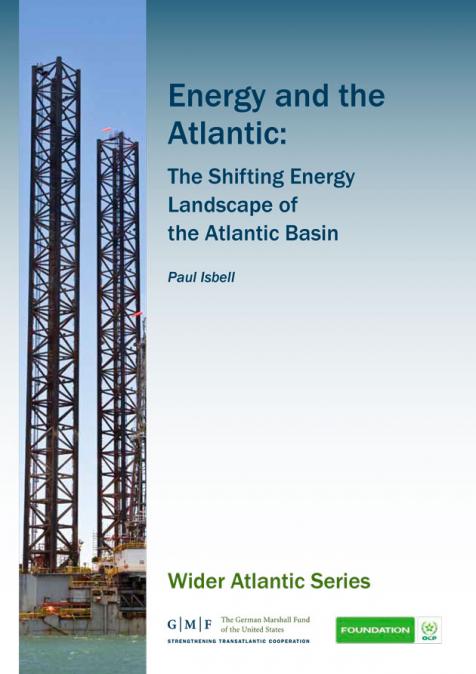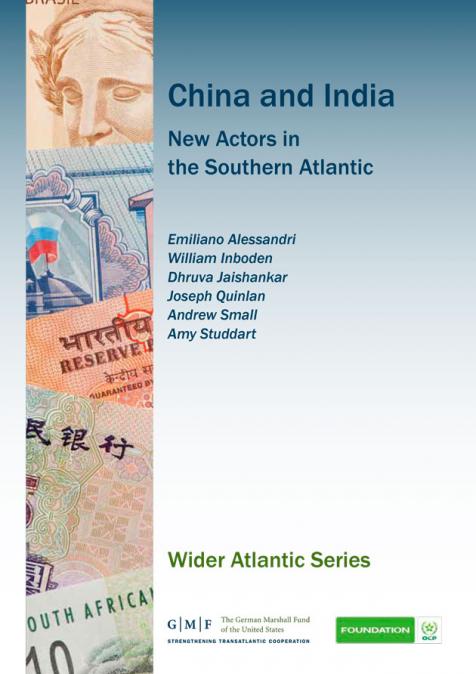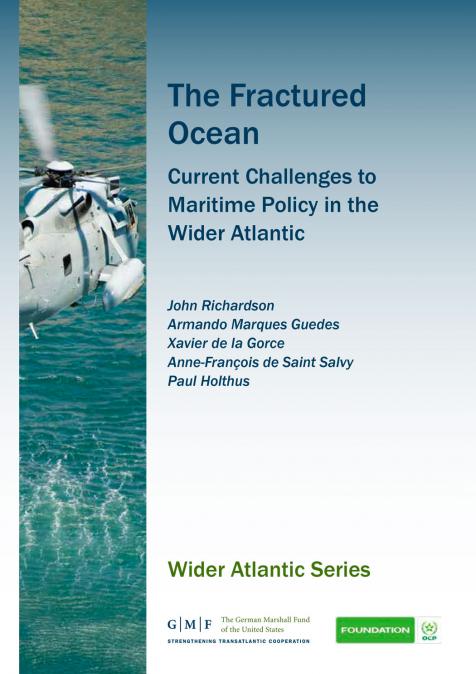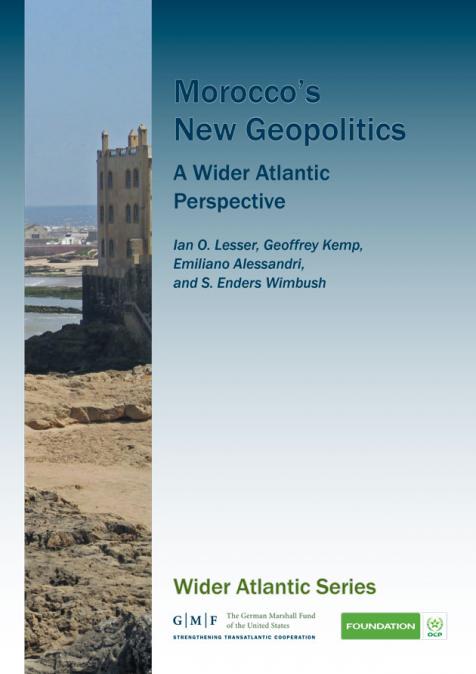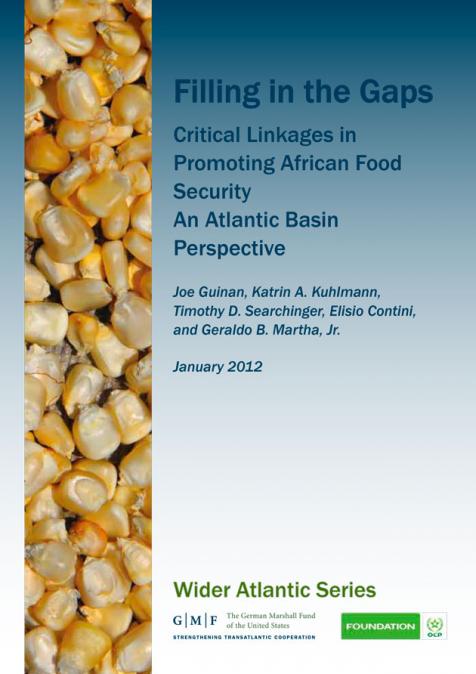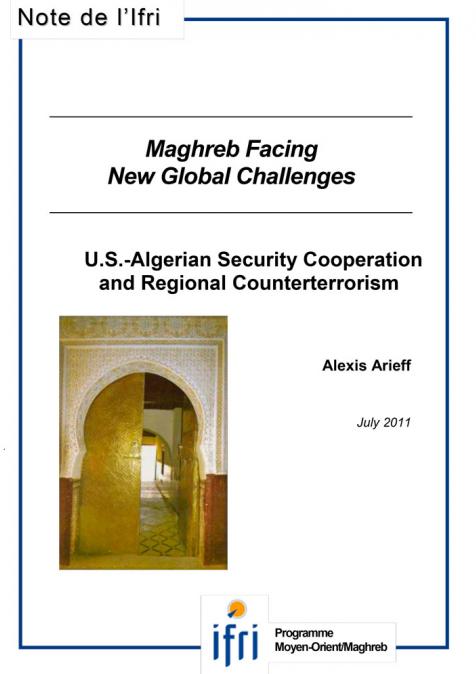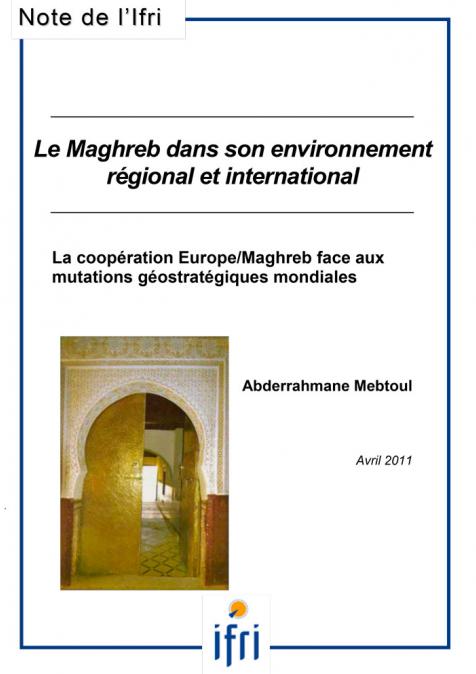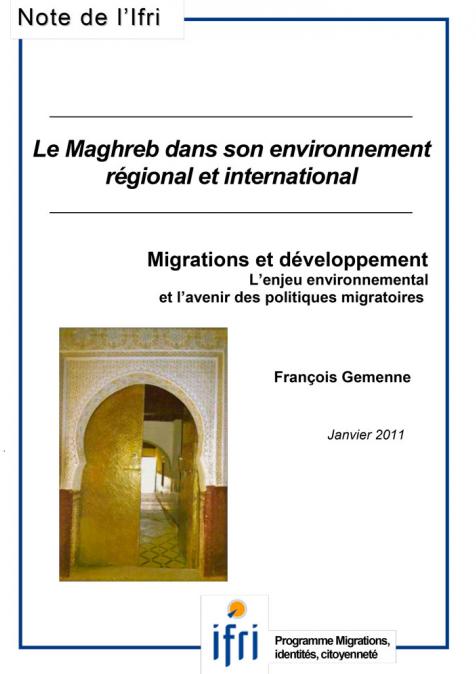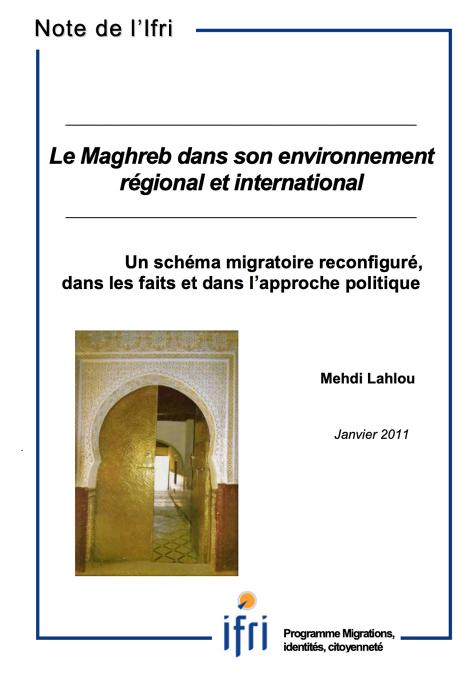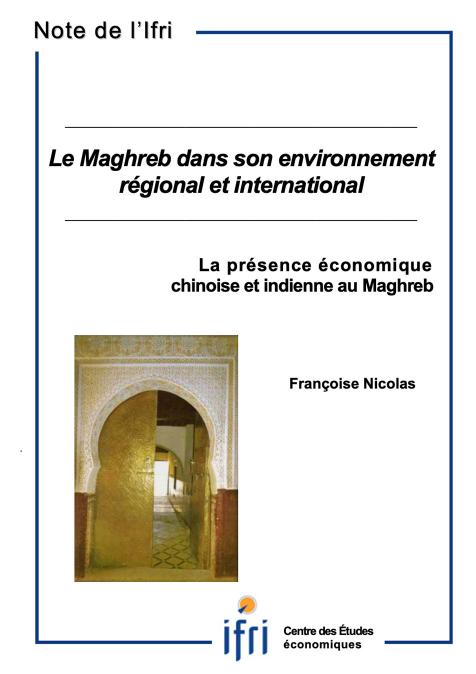Publications /
Opinion
Household, community-, or national-level stability in income, consumption, or assets, and the supporting foundations thereof are a neglected area of analysis and concern among economists and policymakers. Household- and firm-level investment decisions are clearly made with regard to a variety of factors, including but not exclusively the macroeconomic environment that sets the framework for other decisions. Economists typically disregard such diversity of factors when they approach stability either only at aggregate levels or based on micro-foundations of hyper-rational agents and smooth/efficient market adjustments.
We think there is room for a conceptual discussion of how relatively well-worn notions of macro-stability relate to concrete micro-level dimensions, and how the role of stabilizing policies, programs, and entrepreneurial innovations interact with the stability context of economies, influencing household and firm-level investment decisions. Here we outline how various sub-macro levels of governance and institutions (both private and public) influence economic stability and therefore economic decision-making, particularly for people and firms in less economically-stable contexts, and point out the emergence of a new political economy of innovation for economic stability emerging from the rapidly-evolving technology environment.
Stability as macro- and social-political but not micro?
Typically, when “stability” arises in global development conversations, it does so in one of two contexts. These “conventional” uses of the term are:
(1) Macroeconomic stability- referring to stable performance of the macro-economy, usually referenced in terms of GDP growth rate, national debt levels, and currency value, which depends on the country’s capital account and overall health of the financial system (e.g. capitalization of banks). See Reut Institute for a discussion of common elements.
(2) Political and social stability, today usually in the context of avoidance of catastrophic disruption to internal stability resulting from political violence, war, famine, extremism, and often with respect to fragile states that are at risk of becoming “failed states.” (See DFID, Economic Development Strategy, 2017). An important branch of this definition is in “stabilization” efforts which are typically implemented during conflict or in the immediate post-conflict period, for example, stabilization efforts in Afghanistan, Iraq, and Libya have attempted to restore basic order, social cohesion, governance, public services, and economic activity/markets in these conditions.
The concept is also frequently mentioned as a counterpart to “growth” or “prosperity” (e.g. “our goal is global growth and stability”), and normally incorporates both of the above meanings—freedom from macroeconomic crises and destabilizing political events.
In the relatively rare cases that “stability” is used in international development conversations related to inclusive economies or household economic strengthening, it is often mentioned without a clear theory of change or causal link to desired outcomes. For example, a number of publications proclaim the importance of SME sector growth to economic stability, but do not rigorously define this relationship. See this from EBRD, and this example from Pakistan. Similarly, (development sector) products such as improved cook stoves may assert a link between cost savings on cooking fuel (firewood) to economic stability without defining this relationship (see an example here). Even in comprehensive assessments of social protection programs, such as a recent ODI/DFAT review, stability was framed as an upstream (macroeconomic stability and growth) or downstream goal (social stability), rather than a household- or community-level objective. It is generally not treated as the many economists see it—as a set of micro- level policy and institutional mechanisms by which macro stability either becomes “real” for individual and firm-level decision-making (e.g. stimulating investment) or becomes less relevant because of the weaknesses in these institutions. This is somewhat ironic because nearly half of the indicators in WBG’s Doing Business relates to predictability of performance of the business environment- a foundation of stability.
What do we mean by “stability”?
A broader definition offered by Benner and Pastor (2016) begins with the proposition that a stable economy is one in which “individuals, communities, businesses and governments have a sufficient degree of confidence in the future and an increased ability to predict the outcome of their economic decisions. Individuals, households, communities and enterprises are secure enough to invest in their future. Economic systems are increasingly resilient to shocks and stresses, especially to disruptions with a disproportionate impact on poor or vulnerable communities.” They operationalize this definition within three broad areas. These are: (1) Public and private confidence in the future and ability to predict outcome of economic decisions; (2) Members of society are able to invest in their future. (3) Economic resilience to shocks and stresses. Each of these sub-dimensions and the associated indicators commingle macro- and micro-level issues (as well as meso- issues of institutional performance). They also provide several dimensions that “nest” neatly beneath better-understood (more widely discussed) macroeconomic dimensions (see figure 1).
Figure 1- Economic stability indicators from macro to micro
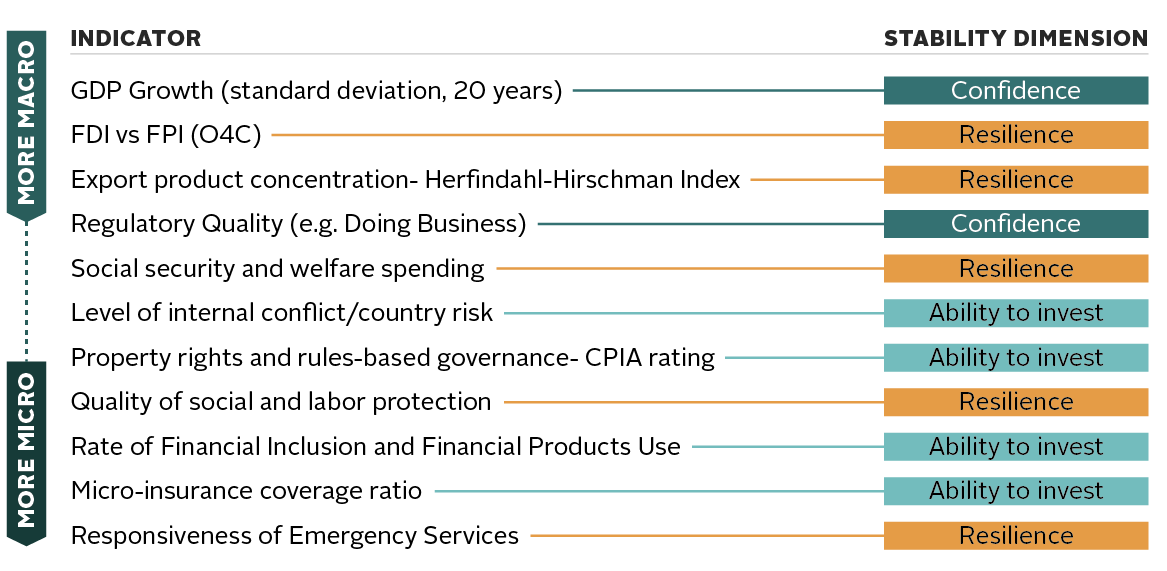
The above indicators are proxies, chosen because of their alignment with the dimensions measured and, for the most part, based on data that is readily available. A slightly more complete “funnel” of stability would also include national- and local-level institutions and systems that are notoriously hard (though not impossible) to measure comparably, and include innovations and services provided by both public and private actors which serve to translate the benefits of greater macro stability into broader-based/inclusive economic growth and development (figure 2 below). For example, at the base of this funnel is basic documentation of personhood (SDG Target 16.9, legal identity for all), and land and property rights, particularly for women and marginal communities. As with each level of the funnel, the absence of robust local systems to ensure these conditions can reinforce informality and economic exclusion, reducing the benefits of a stable macroeconomic context. Similarly, the benefits of macro stability can be greatly reduced in the absence of well-functioning labor markets, low personal security, or exclusion from financial and insurance marketplaces.
Figure 2- A Macro-Micro “funnel” of economic stability
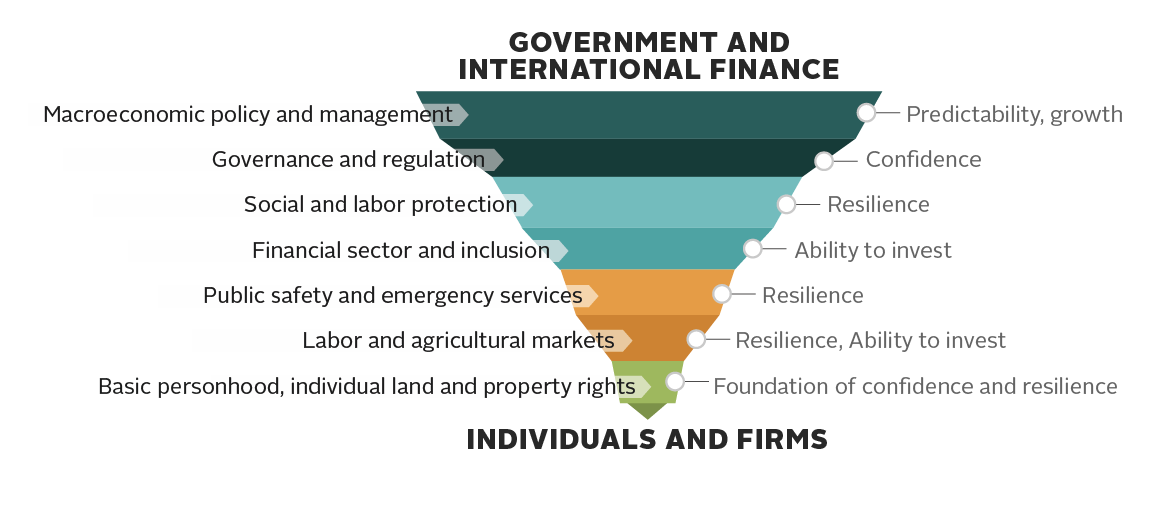
All of this argues for both top-down and bottom-up approaches to stability. It also calls for more attention to the levels through which macro stability is transmitted before it reaches individual decision-makers (firms, households, and individuals), and to the concerns of these decision-makers that are not macro-, that constrain or influence their investment decisions and, in turn, generate or impede inclusive economic growth. It offers the beginnings of a more “behavioral” way of thinking about what constrains actors in less stable lower-middle and lower income contexts from pursuing investments in education, skills, capital goods, and other drivers of growth and productive transformation.
It also clearly suggests that you can go too far with macro reforms to the extent that they undercut stability-transmitting or enhancing institutions/levels such as personal safety, extreme instability in labor markets, or, for example, a stability-eroding imbalance between FPI (hot money) and more permanent FDI. Economists in multilateral institutions, and those responsible for economic planning and risk assessment, should consider the sub-macro dimensions of stability as they impact household- and firm-level decision-making more carefully, while also exploring how to incorporate data on the impact of private financial and non-financial services uptake alongside more common indicators of economic performance.
Innovations for Economic Stability
In several of these areas, there is also a wealth of innovation by governments, global development actors, and entrepreneurs (technologists) that is less readily measurable, but that provide greater stability in income, assets, and consumption, and specific innovative policies and practices in each of the three foundational dimensions. FHI 360’s current work supported by The Rockefeller Foundation is focused on the landscape of innovation activity supporting each of these dimensions, focusing in particular on innovations in financial services, social and labor protection, personal security, and data and services that can make both workforce participation and own-account work (e.g. subsistence agriculture) more stable. Most of the innovations we’ve discovered operate at the level of direct service provision to citizens and market actors.
Watching privately-provided products and services that enhance stability —particularly those that use widely-available mobile technology—provides important “tells” about the sub-macro stability concerns that are in play (and that transmit or mediate the effects of macro stability) in terms of the factors impacting people’s economic and personal decisions. For example, in Brazil and Kenya, several mobile-based services use crowdsourced, geo-located reports of gunfire to help individuals navigate urban areas while preserving basic personal safety. Global brand owners are encouraging local subcontractors in the garment, apparel, and footwear industries to institute worker welfare programs enabled by mobile phone-based communication, including transparent grievance systems, backed by advanced data analytics. International NGOs are aggressively experimenting with digital identities for refugees and others lacking basic proof of personhood—using blockchain/distributed digital ledgers—and for land-titling. And of course, micro-insurance products and borrowing systems for own-account agricultural and other workers—big data on small devices—are driving the FinTech revolution forward, particularly in Sub-Saharan Africa. One financial application now in use in the U.S.—San Francisco-based Even—uses proprietary algorithms to provide consumption-smoothing finance to employees whose incomes vary month-to-month, automatically subtracting funds from accounts in months in which income is above average in order to provide those funds in months in which income falls below the average. These and other innovations will be featured in an Atlas of Economic Stability to be published by FHI 360 later in 2018.
There is a good argument to be made that some of these privately-provided services fill gaps in basic governance and service provision by governments, supplementing under-developed social and labor protection and public safety functions; compensating for the impacts of contingent work in less well-regulated (more flexible) labor markets; and, in the case of own-account agricultural and other subsistence workers and enterprises, offering a degree of income stability associated with more advanced economies. This is not necessarily new, as a variety of public-private divisions of labor co-exist throughout world.
Our observation, however, is that the proliferation of privately-provided digital services is part of a new political economy of stability that is influenced and shaped by current technology and financial trends, both of which put more power into the hands of individual citizens as firms as users, consumers, and buyers, and which replace some public services with private ones, or enhance stability through a locally-appropriate mix. India’s experience building the India Stack—a set of “public good” platform technologies for identity verification, paperless transactions, and digital payments—to facilitate both publicly-provided social benefits and privately-provided services represents the most ambitious effort to date of this type. Built by a team of public and private sector experts and with input from leading technologists, it simultaneously addresses multiple layers of the funnel described above (identity, social protection, and financial inclusion). The open-source and open data interchange system has already stimulated private actors such as Airtel to launch a build a nationwide private payments bank in 2016 (Airtel Payments Bank), and, in 2017, Dalberg and India’s iSPIRIT partnered with prominent investment funds to conduct the Build on India Stack Venture Pitch Competition to “unlock new business models or reach previously underserved new customer segments” leveraging the India Stack platforms that drew 180 submissions from early-stage businesses providing e-governance, healthcare, education, fintech, environment and agriculture services.
If a new political economy of inclusive innovation for economic stability is emerging, what can global development stakeholders do to help if flourish, beyond incorporating new data into economic analyses? A clear imperative is to recognize this evolution and remain open to what Bhatia & Bhabha (2017) call entrepreneurial inclusion—building digital ecosystems to promote social and economic inclusion that facilitate entrepreneurial innovation without creating new private monopolies. This entails a deliberate re-thinking of assumptions about both which services government can and should provide in each country context, and about how to most effectively facilitate competition among private entrepreneurs to create products and services that support economic stability. Countries adopting or innovating social protection systems—particularly cash transfers—and the organizations that support them, should carefully consider whether they are using open technology and design protocols that encourage companies and entrepreneurs to “piggy back” inclusive services on these platforms. Environmental and economic resilience efforts should formulate public investment strategies that consider the roles and sustainability of both public and proprietary technologies. Bilateral and multilateral donors seeking to support inclusive growth should continue to support innovation challenges, competitions, and impact investments, but should also consider whether and how programs and national policies can more directly incorporate services provided by innovative entrepreneurs in areas such as agricultural extension services, land titling, labor protection, and public safety.

